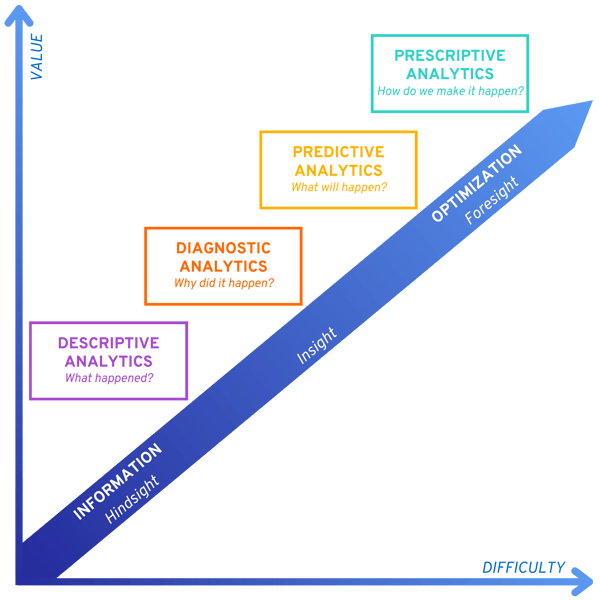In our relentless, ever-accelerating modern world, data has become akin to a gold mine, bursting with valuable nuggets of insight just waiting to be discovered. The power of data doesn't simply lie in its accumulation, but in how we leverage this wealth of information to drive our decisions and actions. In this blog, let's take a closer look at analytics – what it is, the journey it entails, and common pitfalls to avoid along the way.
The Purpose of Analytics
Analytics isn't just about collecting data; it's about using data to make informed decisions that impact the real world. Think of it as a bridge connecting raw data on one side to actionable insights on the other. Picture a Venn diagram where the realms of domain expertise, mathematics, and computer science intersect—this is where data science comes to life. To be an effective data scientist, you must understand what you're dealing with and apply mathematical concepts to drive meaningful results.

But what can you actually do with analytics? It's all about making decisions that matter. Whether it's finetuning maintenance schedules, pinpointing areas ripe for improvement, or steering your business in the right direction, analytics equips you with the tools to do precisely that.
Levels of Analytics
Analytics is a progressive journey, with four distinct levels that build upon each other. You typically can’t leapfrog levels but need to progress from one level to the next. Let's explore these four tiers of analytics:
Descriptive Analytics
Here, we start by looking backward to understand what happened and why. We calculate averages and glean insights from historical data.
Diagnostic Analytics
At this level, we dive deeper into the "why." We build models to understand the motives behind observed patterns.
Predictive Analytics
Now, we're forecasting. We use models based on historical data to predict future outcomes and prevent issues before they arise.
Prescriptive Analytics
Ultimately, it's time for action. We employ analytics to make decisions that drive desired results. Prescriptive analytics help us to optimize processes, mitigate risks, and achieve goals.

The Journey of Data Models
The journey of data models is far from a straightforward path. Analytics isn't a magic wand; it's a process that involves many steps, and an occasional restart. Here's a rough idea of how data model building unfolds:
-
Collect data.
-
Clean data.
-
Build model.
- Validate model.
If it doesn’t pass the validation criteria, then...
-
Collect more data.
-
Build another model.
-
Validate another model.
-
Keep iterating like this until the model meets the validation criteria.
Bear in mind that data analytics can be messy and imperfect, so expect to iterate and adapt as you go.
The Analytics Process
There are five distinct development stages in the analytics process, each with its own set of considerations.
1. Ask a question
What answer will the model provide?
- Is it reasonable? Or are we trying to “boil the ocean”?
- How accurate does the model need to be?
2. Pre-implementation
Define requirements and expectations for the model.
- How is the model going to be used?
- How will it be implemented? What system will it run on?
- How often does it need to run?
- How complex can the model be?
- How much of a black box can it be?
3. Gather data
Identify sources, collect and clean data.
- What data is available?
- Do I have the data I need?
- How much data processing is required?
- How will I treat missing data?
- How do I clean messy data?
4. Build a model
The fun part of the process!
- Subset data into training vs testing vs validation datasets
- What data transformations and normalizations will be used?
- What type of model will meet the requirements and expectations set above?
- How are the factors treated in the model? Discreate, continuous, ordinal?
- What method of acceptance will be used to show the model meets the validation criteria?
5. Implementation
Where the rubber hits the road.
- Does my data translate to the real world?
- Do data transformations work in the real world?
- Can the model run in real time, or does it need to be batched?
- How quickly does it need to run?
Pitfalls to Avoid When Building Models
In the realm of data analytics, there are several pitfalls you should be aware of.
Imbalanced Data
When your data heavily favors one outcome, your model may struggle to predict the less frequent events. Be mindful of this imbalance and consider sampling techniques to address it.
Sampling Bias
Make sure your data is representative of the entire population. Do not draw conclusions based on a skewed sample.
Overfitting
Avoid the temptation to create a model that perfectly fits your training data. An overly complex model may fail to generalize to new data. Utilizing validation is key to avoiding this pitfall.
Extrapolation
Exercise caution when making predictions beyond the range of your data. Extrapolation can yield inaccurate results as your model may be unpredictable outside the range of your data.
Let Data Be Your Guide
Analytics is a journey, not a destination. It's about using data to make informed decisions and continuously improving your models and processes. Along the way, you will encounter challenges and pitfalls, but with the right approach and a solid understanding of your data, you can unlock valuable insights that drive success.
So, whether you're predicting equipment failures, optimizing production, or exploring new frontiers in data analysis, remember that analytics is a powerful tool that empowers you to make better decisions in an ever-evolving world of data. Embrace the journey, learn from the pitfalls, and let data guide your way to success.







Comments